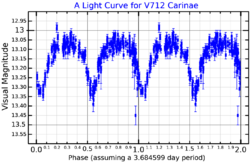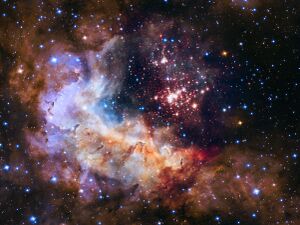Astronomy:WR 20a
WR 20a (circled) near Westerlund 2 Credit: NASA, ESA, the Hubble Heritage Team (STScI/AURA), A. Nota (ESA/STScI), and the Westerlund 2 Science Team | |
| Observation data Equinox J2000.0]] (ICRS) | |
|---|---|
| Constellation | Carina |
| Right ascension | 10h 23m 58.002s[1] |
| Declination | −57° 45′ 48.99″[1] |
| Apparent magnitude (V) | 13.28[2] |
| Characteristics | |
| Evolutionary stage | Hot slash star[3] |
| Spectral type | O3If*/WN6 + O3If*/WN6[4] |
| U−B color index | +0.29[2] |
| B−V color index | +1.63[2] |
| Variable type | β Lyr + WR[5] |
| Astrometry | |
| Proper motion (μ) | RA: −5.391[6] mas/yr Dec.: 2.949[6] mas/yr |
| Parallax (π) | 0.2310 ± 0.0171[6] mas |
| Distance | 14,000 ± 1,000 ly (4,300 ± 300 pc) |
| Absolute magnitude (MV) | −6.49 / −6.49[2] |
| Orbit[7] | |
| Period (P) | 3.675 days |
| Semi-major axis (a) | 26 R☉ |
| Eccentricity (e) | 0 |
| Semi-amplitude (K1) (primary) | 353.1 km/s |
| Semi-amplitude (K2) (secondary) | 362.6 km/s |
| Details[2] | |
| Primary | |
| Mass | 82.7±5.5 M☉ |
| Radius | 19.3±0.5 R☉ |
| Luminosity | 1,150,000±150,000 L☉ |
| Surface gravity (log g) | 3.8 cgs |
| Temperature | 43,000±2,000 K |
| Secondary | |
| Mass | 81.9±5.5 M☉ |
| Radius | 19.3±0.5 R☉ |
| Luminosity | 1,150,000±150,000 L☉ |
| Surface gravity (log g) | 3.8 cgs |
| Temperature | 43,000±2,000 K |
| Other designations | |
| Database references | |
| SIMBAD | data |
WR 20a is an eclipsing binary star belonging to or recently (0.5 millions years before present) ejected from the young, massive cluster Westerlund 2.[8] It was discovered in 2004 to be one of the most massive binary systems known, for which the masses of the components have been accurately measured.[7]
Each star in the system has about eighty times the mass of the Sun.[7][9] It is not clear why this system is located away from the center of the cluster. It is possible that the system was formed in the core, but that it was ejected by dynamical interactions.

Every 3.6 days the two stars in this system revolve around each other. Although the stars are in a very tight orbit, both stars in the system are detached.[11] The two stars eclipse each other on each orbit, producing a drop in brightness of about 0.4 magnitudes. The brightness is also continuously variable outside the eclipses due to the distorted shapes of the two stars.[9] The primary and secondary minima are almost the same depth since the size and temperature of each star is almost identical.[2]
It is expected that within a million years the two will expand and come into contact. A large nitrogen abundance has been measured on the surface of the stars,[2] about six times the abundance of nitrogen measured in the sun. This nitrogen is probably produced in deeper layers of the star and pushed towards the surface by rotational mixing.
A collision between the two winds of the systems has been detected in the visible as well as in X-rays.[2][12] The X-ray emitting region is quite extended since it does not suffer from any eclipse.
See also
References
- ↑ 1.0 1.1 Cutri, Roc M.; Skrutskie, Michael F.; Van Dyk, Schuyler D.; Beichman, Charles A.; Carpenter, John M.; Chester, Thomas; Cambresy, Laurent; Evans, Tracey E. et al. (2003). "VizieR Online Data Catalog: 2MASS All-Sky Catalog of Point Sources (Cutri+ 2003)". CDS/ADC Collection of Electronic Catalogues 2246: II/246. Bibcode: 2003yCat.2246....0C. http://vizier.u-strasbg.fr/viz-bin/VizieR?-source=II/246.
- ↑ 2.0 2.1 2.2 2.3 2.4 2.5 2.6 2.7 Rauw (4 March 2005). "The spectrum of the very massive binary system WR 20a (WN6ha + WN6ha): Fundamental parameters and wind interactions". Astronomy & Astrophysics 432 (3): 985–998. doi:10.1051/0004-6361:20042136. Bibcode: 2005A&A...432..985R. https://pure.uva.nl/ws/files/2178609/46516_211088y.pdf.
- ↑ Crowther, Paul A.; Walborn, Nolan R. (2011). "Spectral classification of O2-3.5 If*/WN5-7 stars". Monthly Notices of the Royal Astronomical Society 416 (2): 1311. doi:10.1111/j.1365-2966.2011.19129.x. Bibcode: 2011MNRAS.416.1311C.
- ↑ Roman-Lopes, A. (2013). "An O2 If*/WN6 star caught in the act in a compact H II region in the starburst cluster NGC 3603". Monthly Notices of the Royal Astronomical Society 433 (1): 712–718. doi:10.1093/mnras/stt762. Bibcode: 2013MNRAS.433..712R.
- ↑ Samus, N. N. et al. (2009). "VizieR Online Data Catalog: General Catalogue of Variable Stars (Samus+ 2007-2013)". VizieR On-line Data Catalog: B/GCVS. Originally Published in: 2009yCat....102025S 1. Bibcode: 2009yCat....102025S.
- ↑ 6.0 6.1 6.2 Brown, A. G. A. (2021). "Gaia Early Data Release 3: Summary of the contents and survey properties". Astronomy & Astrophysics 649: A1. doi:10.1051/0004-6361/202039657. Bibcode: 2021A&A...649A...1G. Gaia EDR3 record for this source at VizieR.
- ↑ 7.0 7.1 7.2 Rauw (3 June 2004). "WR20a: a massive cornerstone binary system comprising two extreme early-type stars". Astronomy & Astrophysics 420 (2): L9–L13. doi:10.1051/0004-6361:20040150. Bibcode: 2004A&A...420L...9R.
- ↑ Rate, Gemma; Crowther, Paul A.; Parker, Richard J. (2020), "Unlocking Galactic Wolf–Rayet stars with Gaia DR2 – II. Cluster and association membership", Monthly Notices of the Royal Astronomical Society 495: 1209–1226, doi:10.1093/mnras/staa1290
- ↑ 9.0 9.1 Bonanos, A. Z.; Stanek, K. Z.; Udalski, A.; Wyrzykowski, L.; Żebruń, K.; Kubiak, M.; Szymański, M. K.; Szewczyk, O. et al. (2004). "WR 20a is an Eclipsing Binary: Accurate Determination of Parameters for an Extremely Massive Wolf-Rayet System". The Astrophysical Journal 611 (1): L33–L36. doi:10.1086/423671. Bibcode: 2004ApJ...611L..33B.
- ↑ Kochanek, C. S.; Shappee, B. J.; Stanek, K. Z.; Holoien, T. W.-S.; Thompson, Todd A.; Prieto, J. L.; Dong, Subo; Shields, J. V. et al. (October 2017). "The All-Sky Automated Survey for Supernovae (ASAS-SN) Light Curve Server v1.0". Publications of the Astronomical Society of the Pacific 129 (980): 104502. doi:10.1088/1538-3873/aa80d9. Bibcode: 2017PASP..129j4502K.
- ↑ Rauw (1 March 2007). "Early-type stars in the core of the young open cluster Westerlund 2". Astronomy & Astrophysics 463 (3): 981–991. doi:10.1051/0004-6361:20066495. Bibcode: 2007A&A...463..981R.
- ↑ Naze (1 May 2008). "Chandra monitoring of the very massive binary WR20a and the young massive cluster Westerlund 2". Astronomy & Astrophysics 483 (1): 171–182. doi:10.1051/0004-6361:20078851. Bibcode: 2008A&A...483..171N.
 |


